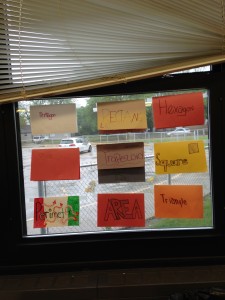I want to do the classroom tips for August. Readers liked last August’s tips, and many teachers who are getting started can use advice from someone who worked in “disadvantaged” classrooms through the years. Education courses seldom provide much help in finding one’s footing in urban and financially-hungry districts. Courses teach aspiring teachers how to make spiffy lesson plans in a time when those teachers may not even be allowed to make lesson plans because all the plans have been scripted in advance by curriculum committees who are matching lessons to the Common Core, rather than actual student learning levels.
My problem with the tips will be that I am simultaneously trying to write a book out here. Why am I writing a book? In part, because if I do not write this book soon, I may never write it. The years have rolled by and my indignation has faded, replaced by a stunned fascination, as I watch the Common Core unrolling around me. Tests created to go with the Core, such as the PARCC and Smarter Balanced tests, appear to have failed a frightening percentage of the students who took those tests. Yet we continue to create and trumpet new, harder standards and tests, as if those standards and tests will themselves somehow solve the educational problems besieging America’s inner cities and other scholastically-challenged playing fields.
Exactly HOW these new, harder tests will cure America’s educational ills receives little or no discussion, probably because details of this “plan” have never been thought out. For one thing, detailed consideration might result in the realization that the educational leaps demanded require additional funding — a realization that our leaders have been ducking since No Child Left Behind attacked schools with a huge, unfunded mandate that unsurprisingly failed ignominiously Government leaders and educational administrators seem to have been on a “Field of Dreams” marathon. If we raise the bar, students won’t necessarily jump that bar. Our problems have reached levels that standards themselves can never address. The Common Core seems to me to be another No Child Left Behind — another attempt to find a simple solution to a set of complex problems, many of which have nothing to do with where we set bars. I can put the bar anywhere I like for Javier, but if he reached middle school unable to read, he won’t manage to jump that bar.
Unfortunately, we teachers are often our own worst enemies, as we adapt, adapt, adapt. New mandates come down from above and we make do. Teachers keep making do. Another test? Quick! Find me #2 pencils! Find me computers! After the first wave of horror, we begin developing our survival rules. Rule #15: Feed them the free Apple Jacks and make sure they have pencils and/or laptops for the test. Rule #34: Seize water bottles before they leave the room since the bottles make great squirt guns; Seize bottles with holes in the lid immediately. Rule #62: Never sit Jenny next to Marisol.
Well, I suppose I should give my tip for the day. I apologize to newbies who find this post lacking in cheer. I still love teaching. I still love the kids. In many districts, especially districts with money, teaching remains a creative and rewarding field, filled with happy moments and enthusiastic students.
But testing really has spiraled out of control, as newbies will discover.
So here is Tip #2: Lay in a supply of word searches and crossword puzzles. Look up http://www.discoveryeducation.com/free-puzzlemaker/ or other sites that allow you to create targeted puzzles. Start creating your post-test library of activities to use to keep students occupied and quiet after they have finished their latest test. You can also buy activities from Teachers Pay Teachers. Some activities at this site are free.
The toughest part of a test comes after students began finishing. Some kids will take the whole time period. Others will blast through that test in less than half a period sometimes.
You need work for after the test. You also need to spell out the rules for after the test. Tell students directly that they cannot talk. Make sure they have pencils for the “Bridge to Terabithia” crossword puzzle, and know exactly where that puzzle is located if you are not passing out the crossword yourself. Have a back-up wordsearch, too, or another puzzle of your choice. The idea is nobody runs out of work — nobody, nohow, never.
I suggest avoiding artsier projects like those in the picture above after tests unless your classroom functions exceptionally well independently. You are trying to avoid questions and interruptions. You also don’t want kids to rush through the test so they can cut construction paper and use the glitter glue.

